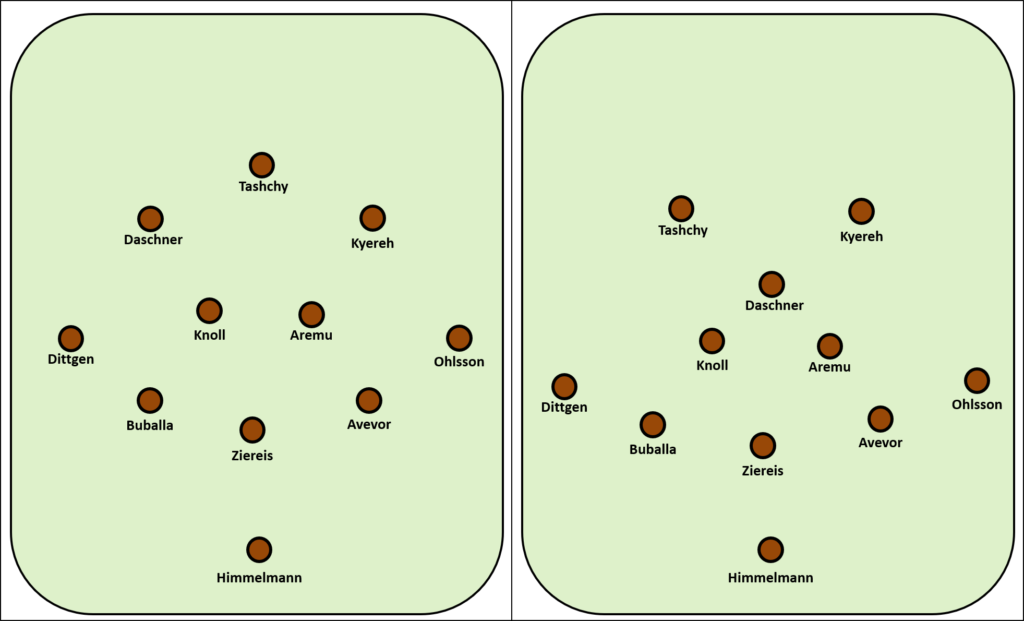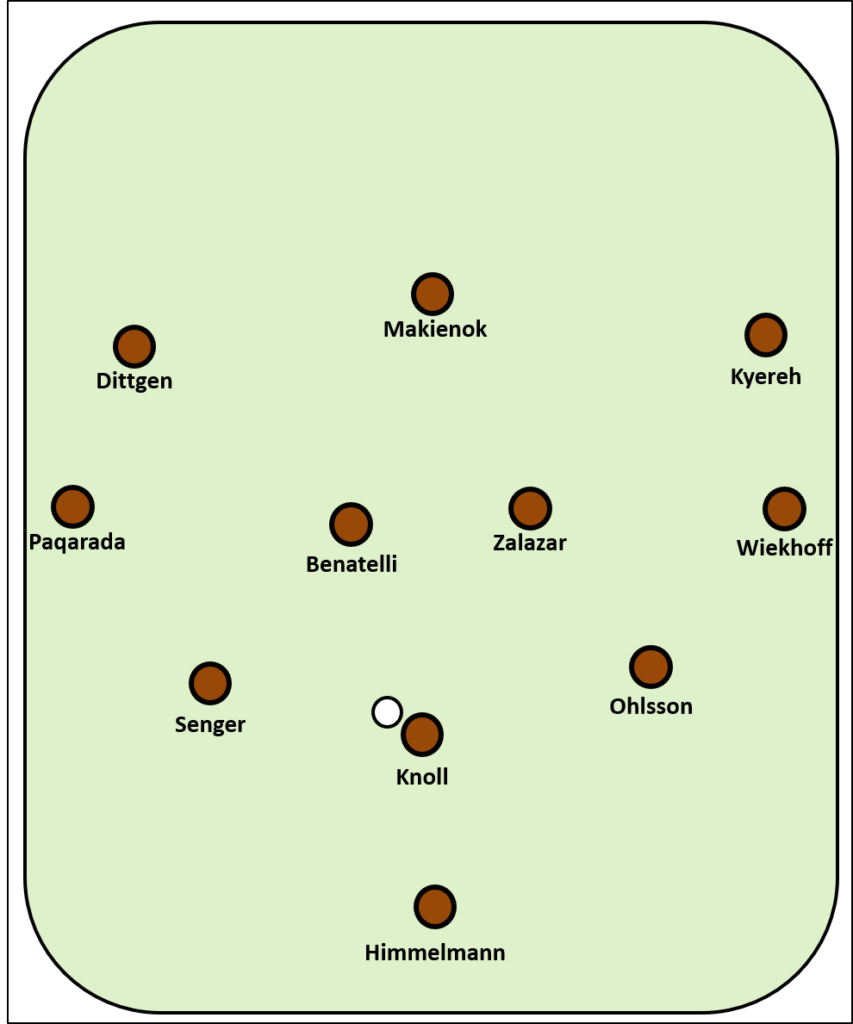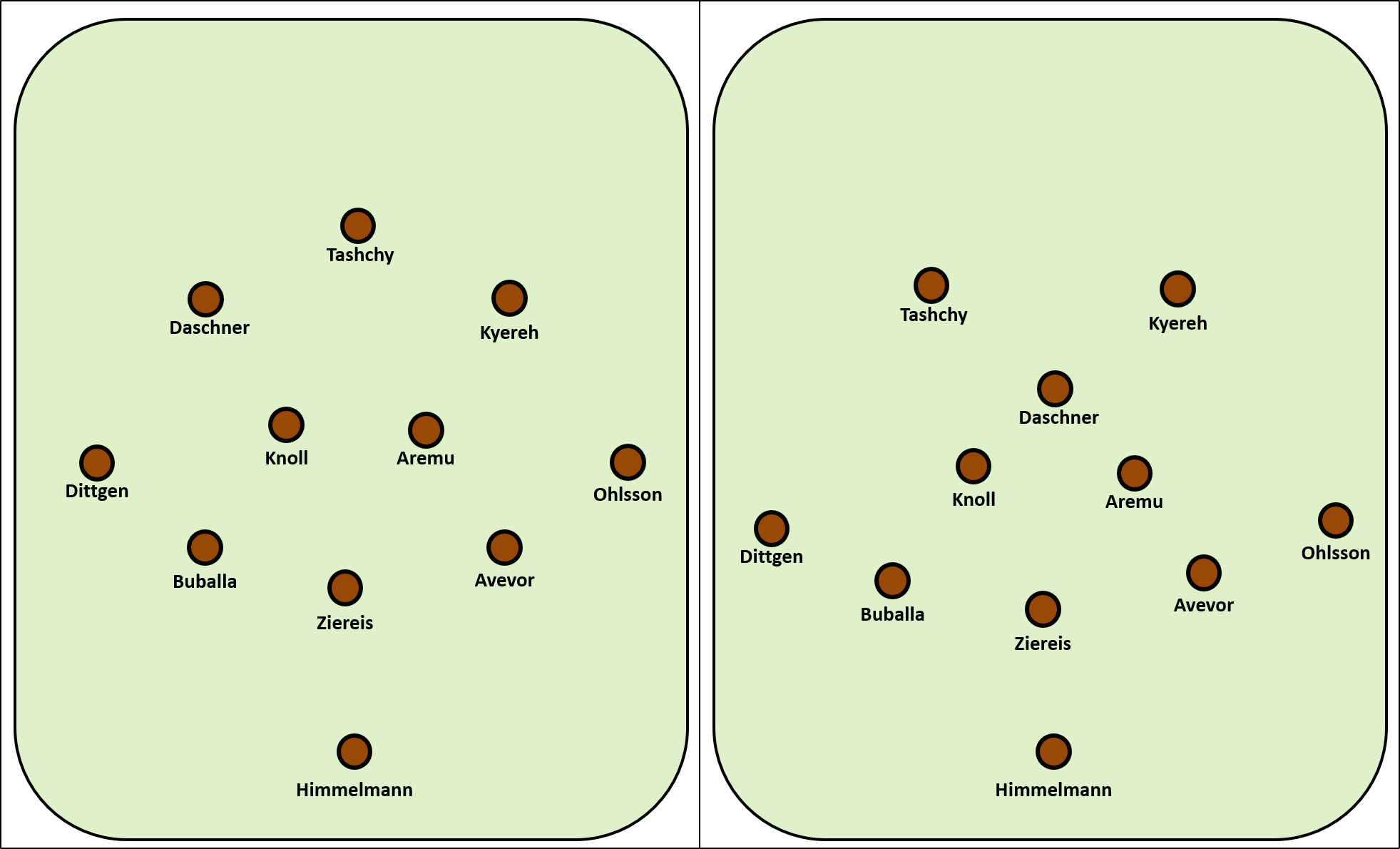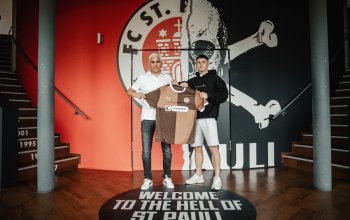Das letzte Testspiel vor dem Pflichtspielauftakt gewann der FCSP mit 1-0 gegen SønderjyskE Futbold. Der Testspielsieg darf durchaus als verdient bezeichnet werden. Da ich bekanntlich mein Herz ein wenig an taktischen Dingen auf dem Fußballplatz verloren habe, möchte ich die Eindrücke des gestrigen Spiels und die Neuerungen im Spiel des FCSP unter Timo Schultz etwas genauer beleuchten.
Es scheint als habe sich der FCSP auf eine Dreierkette als Formation der Wahl festgelegt. Zumindest wurde damit gestern über die volle Spielzeit agiert. Die Formation lässt sich am besten als ein 3-5-2 beschreiben. Und diese Formation hat recht gut funktioniert, denn dem einen Tor hätten durchaus noch ein paar weitere folgen können. Und andersherum gab es keine nennenswerten Abschlüsse gleicher Güte des Gegners.
FCSP im Spielaufbau 1. Halbzeit
Die Dreierkette bestand aus Buballa, Ziereis und Avevor. Als Flügelvertediger agierten Dittgen links und Ohlsson rechts. Zentral waren Aremu und Knoll aktiv, während Daschner und Kyereh in den offensiven Halbräumen und Tashchy meist zentral vorne agierte.
Auffällig im Spielaufbau war das enorme Hochschieben der Flügelverteidiger auf die Höhe der letzten Kette von SønderjyskE. Noch bemerkenswerter und damit ein klarer Unterschied zu vorherigem Agieren mit einer Dreierkette war das Positionsspiel von Daschner und Kyereh. Die ordneten sich zwar auch immer in der letzten Kette ein, stachen von dort aber immer wieder in die Halbräume, um als Relay-Station für den Aufbau zu dienen. In den seltensten Fällen konnten sie direkt aufdrehen. Ohnehin wurde zum Aufdrehen immer das „Spiel über den Dritten“ genutzt, bei dem ein Spieler den Ball mit dem Rücken zum Tor nur kurz klatschen ließ zu einem Spieler der bereits mit Blickrichtung gegnerisches Tor positioniert war. Das ist beileibe keine neue Erfindung, aber beim FCSP wurde bisher selten so strukturiert damit agiert.
Bemerkenswert war auch, dass die beiden äußeren Innenverteidiger, Buballa und Avevor, doch recht weit mit Ball vorrückten, wenn der Raum es hergab. Und davon gab es genug in der ersten Halbzeit, da durch die hohe Positionierung der Flügelverteidiger die gegnerischen Spieler gebunden wurden (und SønderjyskE doch sehr zentrumsfokussiert in diesen Teilen des Spielfelds presste).
Auffällig auch, dass nach Erreichen solcher Räume der Punk auf der anderen Seite abging und sich dort durch schnelles Einlaufen immer wieder eine Option für Diagonalbälle geschaffen wurde (besonders Daschner hat diese Räume bei SønderjyskE häufig erkannt und wollte sie nutzen).

Die beiden Flügelverteidiger schieben enorm hoch. Dadurch konnten die äußeren IV’s mit Ball am Fuß häufig in die Halbräume dribbeln. Daschner und Kyereh waren zwar auch in der letzten Kette positioniert, aber ließen sich von da häufig fallen und waren wichtige Anspielstationen.
FCSP defensiv
Auch defensiv hat sich beim FCSP einiges geändert. Die häufig bemühte, aber eher selten gespielte Maßgabe „Vorwärts verteidigen“ wurde im gestrigen Test meist in die Tat umgesetzt. Bei Ballverlust wurde häufig konsequent und kompakt ins Gegenpressing übergegangen. Das funktionierte in Bezug auf die Erspielung von direkten Torchancen in der zweiten Halbzeit besser als in der ersten (Chancen von Kyereh, 62.min, und Makienok, 67.min, als Beispiel). In der ersten Halbzeit führte es aber meist dazu, dass SønderjyskE mal so gar nicht in einen geordneten Aufbau übergehen konnte und erst gegen Ende der Halbzeit überhaupt so etwas wie längere Ballbesitzphasen erhielt. Das gefiel.
Ebenso gefiel die Konsequenz vieler Spieler in der Verteidigung. Von Daschner bis Dittgen hauten sich viele rein, gingen viele Wege mit, um Räume wieder zustellen zu können. Ohne geht es bei dieser Spielweise auch nicht, da durch die Dreierkette und die hohe Positionierung außen schon ein recht offenes Feld für gegnerische Teams vorhanden sein könnte, wenn sie denn nach Ballgewinn richtig Umschalten.
Ballgewinn ist quasi das Stichwort, um über Afeez Aremu zu sprechen. Egil, der Blogger von IK Start hatte sehr schön formuliert, dass Afeez Aremu der Spieler ist „bei dem die Angriffe des Gegners enden“. Das klang für mich etwas hochgegriffen, denn immerhin gibt es ja auch noch einige andere Spieler, die bei so einem Ballgewinn mitwirken. Aber gestern habe ich dann gesehen, was er meinte: Afeez Aremu ist unglaublich stark darin Bälle zu erobern. Wow! Und nicht nur das, er kann mit dem gewonnenen Ball auch noch eine ganze Menge anfangen. Sicher waren da gestern ein paar Pässe dabei, die vom Timing und der Genauigkeit nicht so gut passten. Aber es scheint mir, als wenn da jemand sehr progressiv im Passspiel unterwegs ist und das ist nicht weniger als zwingend nötig, um aus den Ballgewinnen auch in ein gutes Umschaltspiel zu kommen.
Als Formation würde ich das defensiv sogar nicht als Fünferkette sondern als 3-4-1-2 bezeichnen, im tiefen Pressing. Denn die Flügelverteidiger ließen sich dann doch nicht ganz mit auf Höhe der Dreierkette fallen. Das war aber auch aufgrund der Positionierung von SønderjyskE nicht notwendig und kann in anderen Spielen auch anders aussehen.
Im höheren Pressing agierten Kyereh, Tashchy und Daschner vorne als eine Art Dreierkette, die jedoch nach außen etwas nach hinten abgesetzt war. Erst wenn der Ball von SønderjyskE dann auf die Außenbahn gespielt wurde und der FCSP kein Pressingsignal in Form eines schlecht getimten Passes des Gegners erhielt, formierte sich das tiefe 3-4-1-2.

links: Wenn SønderjyskE den Ball noch tief in der eigenen Hälfte kontrollierte, der FCSP aber nicht hoch presste, formte sich eine Art Tannenbaum beim FCSP (3-4-2-1).
rechts: Im tiefen Mittelfeldpressing rückten die Flügelverteidiger dann deutlicher auf Höhe der Dreierkette und Daschner fiel zentral zwischen den beiden Stürmern ab.
Diese Formation gefiel und der FCSP erspielte sich bis zur 70.Minute eine Vielzahl an hochkarätigen Chancen. Zur 2.Halbzeit ersetzte Makienok Daschner, wodurch Tashchy dann die Daschner-Position übernahm. Grundsätzlich gefällt Tashchy mir persönlich noch etwas besser, wenn er aus einer tieferen Position agieren kann. Die Vorzüge von Makienok wurden dann auch recht schnell deutlich: Ein klasse Wandspieler. Und so jemand ist dann auch besonders wichtig, wenn es im flachen Aufbau Probleme gibt, quasi als eine Art „Exit-Strategie„. Ein Spieler, der immer für lange Bälle zur Verfügung steht und dank dessen Kopfballspiel es fast eine 50/50-Chance ist, dass der FCSP den zweiten Ball dann gewinnt. So ist es dann kein großes Problem und kein „Herschenken“ wenn mal ein langer Ball notwendig wird, da der Druck auf das Aufbauspiel zu hoch ist.
Ein deutlicher Schnitt kam dann in der 70.Minute, als gleich mehrere Spieler ausgewechselt wurden. Das führte auch dazu, dass sich die Grundformation auf dem Spielfeld änderte: Die Dreierkette wurde zwar aufrechterhalten, aber es war im Aufbau nun eher ein 3-4-3, mit zwei klassischen Außenstürmern. Während beim 3-5-2 versucht wurde in die Halbräume zu kommen, ist es wohl hier eher das Ziel auf der Außenbahn voranzukommen, da sich dort recht simpel vertikale Linienzwischen den Spielern ziehen lassen.
Es war aber schon merklich, dass der Wechsel vieler Spieler und der Formation zu einigen Schwierigkeiten in der Umsetzung führte, sodass ich auf jeden Fall einen Favoriten der beiden Formationen habe. Schade, dass man Zalazar und Aremu nicht gemeinsam auf dem Platz sehen konnte. Aufgrund der doch recht ähnlichen Spielweise bin ich mir auch gar nicht sicher, ob beide zusammen auf den Platz passen.

Beide Flügelverteidiger nun wesentlich tiefer positioniert, da vor ihnen zwei klare Außenstürmer agierten.
Es war also ein sehr positiver Test, nicht nur aufgrund des 1-0 Erfolges. Offensiv war das durchaus vielversprechend und es wirkte so, als wenn hinter vielen Aktionen ein wohl durchdachtes Konzept steckt. Kritisch könnte es für diese Art des Spielaufbaus mit vielen Spielern vor dem Ball dann werden, wenn der Druck auf die ballführenden Verteidiger hoch wird (hierzu dann bitte die „Exit-Strategie“ nutzen, wenn es zu hoch wird). Fehlpässe in solchen Momenten könnten schwerwiegendste Folgen haben. Aber während in der Vorsaison immer zentrale Mittelfeldspieler im Aufbau vorne eingerückt sind, waren Knoll und Aremu eher auf potenzielle Rückverteidigung bedacht. Das Zentrum ist bei Ballverlusten also ausreichend besetzt und daher läuft der FCSP hierbei auch nicht ins offene Messer.
Kannste sagen was Du willst (im Zweifel will ich das auch gar nicht hören): Nach den gestrigen Eindrücken freue ich mich auf die neue Saison (zumindest auf den Fußball, nicht darauf, dass ich Taktik-Analysen vor dem Rechner und nicht im Stadion machen darf).
// Tim
Alle Beiträge beim MillernTon sind gratis. Wir freuen uns aber sehr, wenn Du uns unterstützt.
MillernTon auf BlueSky // Mastodon // Facebook // Instagram // Threads // WhatsApp // YouTube





3 thoughts on “FC St. Pauli – SønderjyskE Futbold: Taktische Eindrücke”